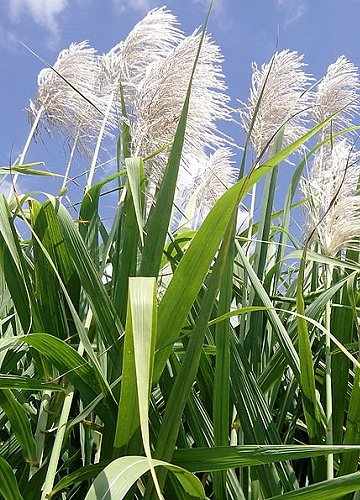
|
|
Sugar cane (Saccharum officinarum).
Leaves and flowers
|
Sugar cane - Saccharum officinarum
Saccharum officinarum, sugarcane, is a large, strong-growing species of grass in the genus Saccharum,
a member of the grass family Poaceae. It originated in southeast Asia and is now cultivated in tropical and subtropical countries worldwide for the production of sugar and other products.
It is widely cultivated, providing around 70% of the world’s sugar. Sugar cane yields the highest number of calories per unit area of cultivation of any
plant.
Sugar cane probably originated in New Guinea, and was taken to the Americas by the explorer Christopher Columbus on his second expedition there in 1493. Sugar cane is now grown in more than 70
countries, mainly in the tropics, but also in some sub-tropical areas.
Sugar cane is grown in southwestern Europe, Africa, temperate Asia, tropical
Asia, Australia, the Pacific, southeastern USA, Mexico, and South America. It has been cultivated in New Guinea since about 6000
BC, and, from about 1000 BC, it was gradually spread along human migration routes to Asia and the Indian
subcontinent. India and Brazil produce about half the world’s cane sugar.
The word 'sugar' is thought to derive from the ancient Sanskrit 'sharkara'.
S. officinarum, a perennial plant, grows in clumps consisting of a number of strong unbranched
stems.
It is a tall grass, which looks rather like a bamboo cane. A network of rhizomes forms under the soil which sends up secondary shoots near the parent
plant. The stems vary in colour, being green, pinkish, or purple and can reach 5 m (16
ft) in height.
They are jointed, nodes being present at the bases of the alternate leaves. The internodes contain a fibrous white pith immersed in sugary
sap. The thicker-stemmed forms are commonly known as 'thick' or 'noble' canes because of their
tall, handsome, colourful stems.
The elongated, linear, green leaves have thick midribs and saw-toothed edges and grow to a length of about
70 to 150 cm and width of 5 cm (2.0 in). They borne alternately on the stem, with leaf base encircling the
stem. The terminal inflorescence is a panicle up to 60 cm (24 in) long, a pinkish plume that is broadest at the base and tapering towards the top. The spikelets are borne on side branches and are about 3 mm (0.12 in) long and are concealed in tufts of long, silky hair. The
fruit is an oblong caryopsis, dry and contains a single seed 1.5 mm long.
Sugarcane harvest typically occurs before the plants flower, as the flowering process causes a reduction in sugar content.
Sugar cane was originally grown in southeastern Asia and the Pacific for the sole purpose of
chewing. The rind was removed and the internal tissues sucked or chewed. The production of sugar by boiling cane juice first took place in
India, most likely during the first millennium BC.
S. officinarum and its hybrids are grown for the production of sugar, ethanol, and other industrial uses in tropical and subtropical regions around the world.
Sugar is now a highly valued food and sweetener and also serves as an edible preservative. Raw and refined sugars are produced by heating, removing impurities and crystallising sugar cane juice, which mainly consists of sucrose.
Raw and refined sugars are exported all over the world for use in sweet and savoury dishes, processed foods and drinks and for preserving fruits and meat. They are also compressed into sugar cubes and made into syrup. White sugar can be further processed (ground into a fine powder) into icing sugar, which is used in desserts, baking and confectionery. In India, the young shoots of sugar cane are sometimes steamed and roasted as a vegetable.
As its specific name (officinarum, "of
dispensaries") implies, Sugar
cane is also used in traditional medicine both internally and externally.
In southern Asia it has been used to treat a wide variety of health complaints from constipation to
coughs, and has been used externally to treat skin problems. Both the roots and stems are used in Ayurvedic medicine to treat skin and urinary tract
infections, as well as for bronchitis, heart conditions, loss of milk production,
cough, anaemia, and constipation. Some texts advise its use for jaundice and low blood
pressure.
Sugar paste has been widely used to pack wounds and aid healing. Sugar is used for hair
removal, in a practice that is thought to date back to the ancient Egyptians. A warm paste of
sugar, water and lemon juice is applied to the skin. Strips of cloth are then pressed over the paste and torn off
quickly, taking the hair with them. Sugar is also used in soap-making and as an abrasive scrub to exfoliate
skin.
The stems and the byproducts of the sugar industry are used for feeding to livestock. Pigs fed on sugarcane juice and a soy-based protein supplement produced stronger piglets that grew faster than those on a more conventional diet.
A by-product of sugar refining is molasses, which is a dark, syrupy product used in the preparation of edible syrups and for numerous industrial products. It is used for animal feed, fertilizers, and even for adding to tobacco for hookah pipes and some cigarettes. Molasses, along with cane juice and other by-products of sugar production, can be fermented and then distilled, to produce rum.
Pure alcohol (ethanol) can also be produced from molasses, and is used in the preparation of vinegar, cosmetics, pharmaceuticals, cleaning preparations, solvents, and coatings. Ethanol produced in this way (bioethanol) is widely used in Brazil and the USA as a motor fuel, as part of a movement to use sustainable alternatives to petrol. Other products produced from molasses include butanol and lactic acid (solvents), citric acid (used in foods and drinks), and glycerol.
Source:
https://en.wikipedia.org/wiki/Saccharum_officinarum
http://www.kew.org/science-conservation/plants-fungi/
saccharum-officinarum-sugar-cane
